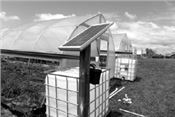|
Low-Pressure Irrigation System Looks Promising For Small Farms

Rainwater catchment and solar + gravity-fed drip irrigation system being installed
or flower crops in a high tunnel at Greenhouse 17.
Photos by Brent Rowell
LEXINGTON, KY.
A low-pressure irrigation system that a University of Kentucky horticulture extension professor perfected in Asia looks like it also will have practical applications for small growers in this country. Farmers who have no easily accessible electricity or water to their field or those who just want to reduce their water bill might find this to be a useful system, according to Brent Rowell.
The College of Agriculture, Food and Environment professor’s focus is on international and sustainable agriculture. Rowell has spent considerable time in Myanmar (formerly Burma) testing and instructing farmers how to install and use a gravity-fed drip irrigation system that can operate under extremely low pressure.
Rowell said the switch to drip irrigation from any other form, especially furrow or flood irrigation, is “revolutionary.”
“It’s a real game-changer. It often doubles farm income right off the bat. With drip irrigation, the water is there at the plant roots when it’s needed, plant growth is so much better, the yields are higher, the quality of the product is much higher and prices are better in the market,” he said. “I knew that would happen because we’d gone through this in Kentucky in the 1980s and ‘90s, where we’d taken farmers from rain-fed to drip irrigation. It’s a dramatic change.”
Whereas the systems he tested in Myanmar relied exclusively on gravity to move water, he recently has tested systems that combine gravity and small, solar-powered pumps. He collaborated with engineers from Ball Aerospace in 2014 to combine low-powered solar pumps of approximately one horsepower with ultra low-pressure drip irrigation in Gujarat state in India. They used the pumps to raise water from open wells to small tanks located about 5 feet above the field, at which point gravity took over to irrigate about an acre of vegetables.
“After we set up one system, the Indians set up nine more,” Rowell said. “They worked extremely well. The concept was proven there.”
Though the solar pumps are often too expensive for the average farmer in the developing world, prices continue to drop and much cheaper pumps are being developed and tested. In the meantime, they’ve readily adopted gravity-fed drip irrigation.
The pressure required to move water through an irrigation system depends on the height the water must be lifted, the distance it travels, the diameter and length of the pipe, the size of the field and the crop itself. Electric or gasoline-fueled pumps of various sizes and power can provide that pressure, but a gravity-fed system is generally less expensive and more applicable where fuel is scarce or expensive. In that type of system, the weight of the water combined with the height it falls can provide a low-pressure system with enough “push” to succeed. In Southeast Asia, Rowell conducted hundreds of field tests which proved that water could be uniformly applied in this way on plots up to a quarter-acre using low-powered pumps and a gravity tank only 2 to 3 feet high. Such systems were adopted by tens of thousands of fruit, vegetable and flower growers in Myanmar.
Here in Kentucky, Rowell is working with Krista Jacobsen, UK horticulture assistant professor, to test tiny solar-powered bilge pumps with low-pressure drip irrigation in a rainwater catchment system for a high tunnel at UK’s Horticulture Research Farm in Lexington. They have installed another such system at GreenHouse 17, a domestic violence shelter with a working cut-flower farm in Central Kentucky. Farm manager Jessica Ballard is very pleased with the results.
“We love it. It’s awesome,” she said. “I love that it’s just using rainwater and not city water. But I really like the pressure for that system. Even though it’s low pressure, the pressure we get from running (tap) water from the (main) building is terrible. The job of watering is more efficient with this system. We’ve been looking at adding an additional system.”
Rowell has trained about 100 Natural Resources Conservation Service agents across the state in the method and continues to work with collaborators in Myanmar and in Yunnan, China. Several other countries have recently expressed interest, including Haiti, Cuba and Senegal.
“I think this has a place, but nobody’s thought to do it, because you wouldn’t think you could irrigate with such low pressure,” he said. “Now we know we can.” ∆
|
|